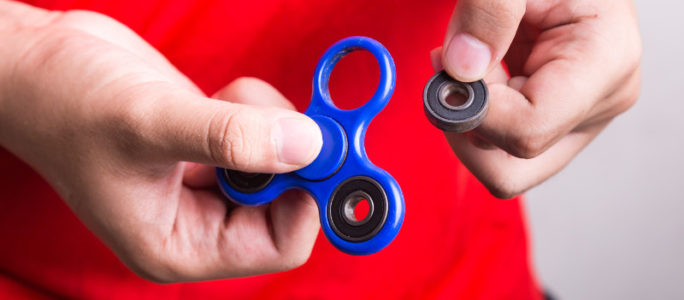As a pediatric gastroenterologist, I’ve seen my fair share of unusual objects in kids’ stomachs. Recently, I joined my colleagues in their concern for fidget spinners potentially causing serious harm to children.
I treated an older child who swallowed a piece that broke off a fidget spinner, which then got stuck in the stomach. We kept an eye on it for a week to see if it would pass through the body. When it didn’t, we had to remove it with an endoscope under general anesthesia. While thankfully the child did okay, I think this incident serves as a reminder to be especially vigilant about products and toys on the market that could be swallowed and cause undesirable effects.
As more news articles pop up with similar stories, the Consumer Products Safety Commission has committed to investigate their safety. Until that report comes out, I think it’s important for parents to be aware of the choking and ingestion dangers.
Fortunately, the child that I saw was able to inform his parent who then consulted with their pediatrician. What concerns me the most about fidget spinners with easily removable parts is the children using them who are nonverbal. If they swallow it, they’re not going to be able tell their parents.
I’m thinking about children under three and those who have conditions preventing them from communicating, such as those with autism spectrum disorders. If an object stays in your child’s stomach, it could cause belly pain, vomiting, inflammation, bleeding, perforation and ulceration.
New products are constantly coming on the market, so what can parents do to help prevent these types of injuries?
Fidget Spinners and Other Toys: 5 Safety Tips for Parents
- Register new toys. Whenever your kids receive a new toy, register it on recalls.gov. That way, if one of them has a safety concern and has been recalled, you will receive an alert.
- Review the packaging. If your kids’ toys have warning labels on them, follow the instructions, including the age limits. If you also have a baby or toddler in the home, be hyper-vigilant about when and how the toy is played with.
- Be aware of small parts. If you notice that a toy has small parts that your baby or toddler could choke on or swallow, create rules around how the older child can play with it. For example, Legos are only played with in the older child’s room and keep the baby out of it.
- Pitch broken toys. If a piece of your child’s toy has broken loose and is big enough to choke on, get rid of it. It just isn’t worth keeping it around.
- Report issues. If you notice that a toy has a broken part, notify the Consumer Products Safety Commission. You may be able to help prevent an injury from happening to another child in the future.
Kids of all ages are naturally curious. While it isn’t realistic to think that we can prevent all injuries from happening, following these safety guidelines and being aware of the types of toys they’re playing with may help avoid a trip to the gastroenterologist.






Dr. Kaul is the BEST! I will miss bringing my son Caleb to him as he’s been treating his GI problems for at least three years now. He gave us a referral to a doctor he knows at our Children’s Hospital in Pittsburgh due to the sudden unexpected passing of my husband on January 4th 2020. I cannot drive the four hours to the clinic to see him with my son. If you bring your child to him, you will not regret it, he’s a wonderful doctor and person.